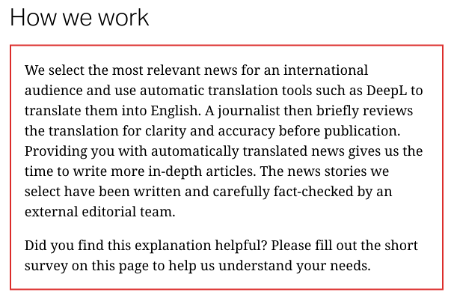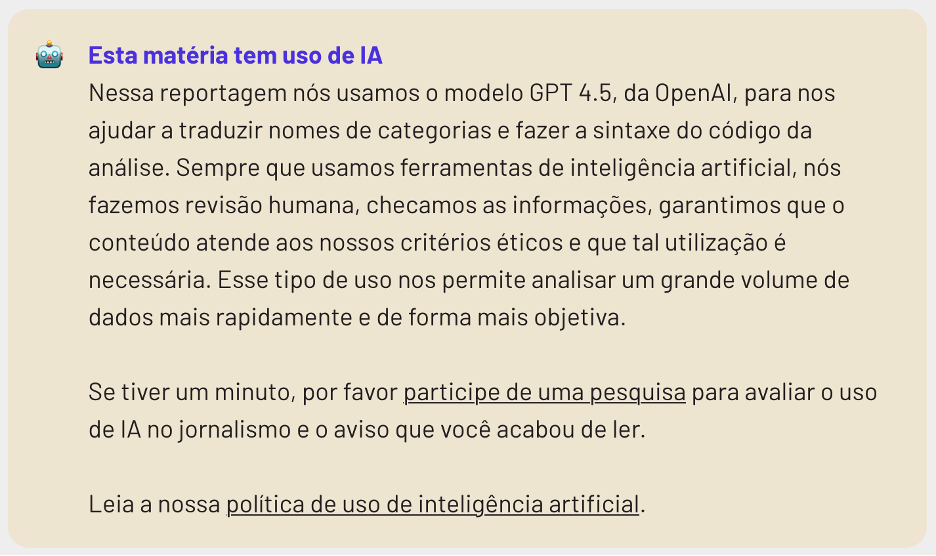News audiences, by and large, want journalists to disclose when they use artificial intelligence in their work.
That’s the big takeaway from recent surveys led by Trusting News, a nonprofit that helps news organizations build trust with their audiences.
Joy Mayer, founder of Trusting News, presented the survey findings at the Investigative Reporters and Editors annual conference last month in New Orleans.
“A lot of the public kind of assume journalists are already using AI but are really confused about what that would mean, how that might look,” Mayer said at the conference, citing May 2024 research from the Reuters Institute for the Study of Journalism at the University of Oxford.
Newsrooms are most commonly using AI tools to produce summaries of stories, and for transcription and language translation, Mayer said.
The Trusting News surveys were conducted in July and August 2024, with 10 partner news organizations collecting more than 6,000 survey responses from their audiences.
The partner organizations were 100 Days in Appalachia, American City Business Journals, Houston Landing, Iowa Public Radio, KXAN-TV based in Austin, Texas, Science News, The Associated Press, The Texas Tribune, USA TODAY Network and the Voice Media Group. Several organizations solicited survey participants directly on their websites through info boxes or popups.
Among the respondents, 94% said they want newsrooms to generally disclose when they use AI, while 87% said that an AI disclosure should include the reasons why reporters used AI and 92% said they would want to know that a human was involved in vetting AI-generated information.
As a follow-up to the survey, Trusting News created this AI disclosure blurb that newsrooms using AI can tailor to their specific needs:
In this story we used (AI/tool/description of tool) to help us (what AI/the tool did or helped you do). When using (AI/tool) we (fact-checked, had a human check, made sure it met our ethical/accuracy standards) Using this allowed us to (do more of X, go more in depth, provide content on more platforms, etc.).
At the IRE conference, Mayer advocated for transparency from newsrooms using AI in their editorial processes.
“Most evidence of our integrity is invisible to the audience,” Mayer said. “All of the decisions we spend time talking about in the newsroom and patting ourselves on the back, [saying] ‘Look how thoughtful we are, look how responsible we are, look how carefully we made this decision’ — unless we talk about it, we could go home at the end of the day feeling really good, but it doesn’t actually influence public perception.”
Here are four more takeaways from Mayer’s presentation at IRE.
1. Tailor your AI disclosure to your audience.
The details included in an AI disclosure may vary widely depending on the news organization. Some news organizations might only broadly disclose their use of AI, without offering technical information, such as which AI tools were used and why.
Here’s an example from a May 2024 USA Today story:

A June 2024 report from the Reuters Institute suggests younger and tech savvy audiences may be more comfortable with more technical disclosures.
Here is an example of a more technical disclosure that Mayer shared during her presentation. It’s from SWI, the online news home of the Swiss Broadcasting Corporation:

2. Know that audiences may gloss over the same disclosure used over and over.
While it’s important for AI disclosures to match the needs of your audience, Mayer noted AI disclosures that are identical may fail to resonate. “With disclosures in general, if they’re exactly the same all the time, they become noise,” she said.
Mayer pointed to the Brazilian tech news outlet Nucleo as an example of a media organization that has provided varied, usually technical descriptions of their use of AI for individual stories:

3. Build trust with TV or online video audiences by working AI disclosures into stories.
Focus groups have told Trusting News and the Center for Media Engagement at the University of Texas at Austin, that TV news outlets can build trust with them by offering transparency — a look into how and why a particular story was reported.
“We know, in general, that transparency is more effective when it’s worked into the storytelling than when it’s a sidebar or clickthrough or a tagline at the bottom,” Mayer said. “Wherever you can work it in, people notice it more and remember it more.”
As an example of an effective way to do this, Mayer cited this New York Times video investigation that found Israel had dropped bombs in areas where it had ordered Gazan civilians to safety.
Within the video script is this disclosure:
“How often the attacks were launched by Hamas is unclear. But visual evidence indicates Israel was dropping 2,000-pound bombs in the area it was ordering civilians to go. The Times programmed an artificial intelligence tool to analyze satellite imagery of south Gaza to search for bomb craters. The A.I. tool detected over 1,600 possible craters. We manually reviewed each one to weed out the false positives, like shadows, water towers or bomb craters from a previous conflict. We measured the remaining craters to find ones that spanned roughly 40 feet across or more, which experts say are typically formed only by 2,000-pound bombs.”
4. Be aware that disclosures may change as AI tools become more accepted.
For now, audiences want to know when journalists are using AI, but there are some exceptions.
Mayer suggested that news organizations probably don’t need to disclose when their reporters use AI tools, like Chat GPT, as search engines. For example, using Chat GPT instead of Google to research information available online.
Disclosure is more necessary when an AI tool concretely informs or enhances a news organization’s reporting. But that, too, may change over time as audiences begin to more broadly understand how journalists use AI — and audience members become familiar with using AI tools themselves.
“As people get more and more comfortable with something or tools get used more widely, the need to point it out as something unusual and different will decrease,” Mayer said.


Expert Commentary